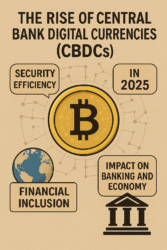The Rise of Central Bank Digital Currencies (CBDCs): A Revolutionary Shift in Finance
The financial world is evolving rapidly, and one of the most significant changes happening right now is the rise of Central Bank Digital Currencies (CBDCs). These digital currencies, issued by central banks, are designed to make money safer, faster, and more efficient.
In 2025, many countries are working on implementing CBDCs. This shift could change how we think about money and its role in the global economy. With CBDCs, transactions will be easier, faster, and more accessible for everyone.
CBDCs are more secure than traditional currencies. They also promise to offer financial inclusion to those who have no access to banks. All in all, CBDCs might just be the future of money, also learn about blockchain investment.

What Are Central Bank Digital Currencies (CBDCs)?
Central Bank Digital Currencies (CBDCs) are digital versions of traditional currencies issued by a country’s central bank. Unlike cryptocurrencies, CBDCs are not decentralized and are regulated by the government.
These digital currencies are designed to be safer and more efficient than physical money. With CBDCs, transactions can happen instantly, without the need for intermediaries. This could be a major improvement in how we make payments.
CBDCs aim to modernize the financial system by offering a more reliable and secure digital payment option. Their impact could be massive, especially in developing nations where access to banking is limited, also learn about how to earn crypto.
Why Are CBDCs Gaining Popularity in 2025?
In 2025, CBDCs are gaining popularity because of their many benefits. They promise to make financial transactions more efficient, reduce costs, and enhance security. Moreover, governments are looking for ways to increase financial inclusion, and CBDCs can help.
Many nations are exploring how CBDCs can benefit their economies. For example, countries like China and the European Union are leading the way in testing these digital currencies. The demand for secure and efficient payment systems is rising, and CBDCs can meet that need.
As more governments see the potential of CBDCs, we can expect to see their adoption grow rapidly. This is not just a passing trend; it’s a shift toward a more digital and secure financial future.
How Do CBDCs Differ from Cryptocurrencies?
CBDCs and cryptocurrencies may seem similar, but they are very different. CBDCs are issued and controlled by a government, while cryptocurrencies like Bitcoin are decentralized. This is one of the key differences between the two.
CBDCs are designed to be stable and secure, as they are backed by a central authority. On the other hand, cryptocurrencies can be volatile, often seeing dramatic price fluctuations. People trust CBDCs because they are tied to a nation’s economy, unlike decentralized digital currencies.
Another difference is in their use. While cryptocurrencies are often used for investments or trading, CBDCs are intended for everyday transactions. This makes them more practical for daily use in economies worldwide.
Countries Leading the Way in CBDC Development
Countries like China, the United States, and the European Union are leading the way in the development of CBDCs. China’s digital yuan is already being tested, while the US and the EU are working on their own versions. These nations recognize the importance of staying ahead in the digital currency race.
China is ahead of most countries in the development of its CBDC. The digital yuan is already being used in various cities, and it’s showing how CBDCs can revolutionize payments. Other countries are closely watching China’s progress to learn from its success.
In 2025, it’s expected that many other countries will start pilot programs or introduce CBDCs to their economies. The rise of CBDCs is becoming a global trend that’s impossible to ignore.
Read about global CBDC initiatives
The Economic Benefits of CBDCs
CBDCs offer significant economic advantages. They can lower transaction costs by eliminating intermediaries, making payments faster and cheaper. This can especially benefit cross-border payments, which are often slow and costly.
Moreover, CBDCs can help boost financial inclusion by giving people without access to traditional banking services the ability to make digital transactions. This could dramatically improve economic opportunities in underserved areas.
In addition, CBDCs will allow governments to implement monetary policies more quickly and efficiently, ensuring economic stability. Overall, these digital currencies could play a crucial role in modernizing the global financial system.
How CBDCs Will Enhance Financial Inclusion
One of the biggest advantages of CBDCs is their potential to increase financial inclusion. Many people around the world still don’t have access to traditional banking services. CBDCs can change that by allowing people to make digital transactions using only a smartphone.
With CBDCs, people in rural or remote areas can gain access to banking without needing a physical branch. This could also reduce reliance on cash, making payments easier and safer.
Financial inclusion is a major goal for governments, and CBDCs could play a key role in achieving it. In 2025, we’re likely to see more efforts to make digital currencies available to people in underserved areas.
CBDCs and Privacy Concerns: What You Need to Know
While CBDCs offer many benefits, they also raise concerns about privacy. Since CBDCs are controlled by central banks, transactions could be tracked and monitored. This is a significant difference compared to cryptocurrencies, which provide more privacy.
Governments will need to find a balance between offering a secure payment system and protecting individuals’ privacy. In 2025, privacy concerns will continue to be a hot topic as more countries roll out CBDCs.
The challenge will be ensuring that CBDCs are secure and efficient while respecting personal privacy. It’s crucial that governments address these concerns to build trust among users.
Will CBDCs Replace Cash?
While CBDCs will likely reduce the need for cash in some areas, they are not likely to completely replace it. People will still use physical money, especially in regions where digital infrastructure is limited.
However, CBDCs will offer a more efficient and convenient alternative to cash. In cities with better digital infrastructure, CBDCs could become the preferred method of payment for everyday transactions.
Over time, the reliance on cash will decrease, but CBDCs won’t entirely replace physical money in the foreseeable future. People will have the choice of using either, depending on their needs and preferences.
The Role of CBDCs in Cross-Border Payments
One of the biggest promises of CBDCs is their ability to improve cross-border payments. Traditional international payments can be slow, expensive, and unreliable. CBDCs could make these payments faster and cheaper, opening up new possibilities for global commerce.
With CBDCs, international transactions can happen almost instantly, reducing the costs of exchange rates and transaction fees. This could make it easier for businesses to operate across borders, leading to a more interconnected global economy.
As countries adopt CBDCs, we can expect to see a dramatic improvement in the speed and efficiency of cross-border payments.
Challenges in Implementing CBDCs
Despite the many advantages, there are significant challenges in implementing CBDCs. One of the biggest challenges is ensuring the security of the digital currency. Governments must protect CBDCs from cyber threats and technical failures.
Another challenge is ensuring that CBDCs are accessible to everyone. In some countries, there may be infrastructure limitations that prevent people from using CBDCs effectively. Governments will need to address these issues to make CBDCs truly inclusive.
Despite these challenges, the benefits of CBDCs are driving countries to find solutions and push forward with their development.
The Future of CBDCs: What’s Next?
The future of CBDCs looks bright. In the coming years, more and more countries will likely introduce their own digital currencies. These currencies could change the way we make payments, interact with businesses, and manage our finances.
By 2025, we may see CBDCs become a standard part of the global financial system. The technology will continue to improve, and governments will refine their policies to address emerging challenges.
As CBDCs evolve, their impact on the global economy will grow. They will likely play an essential role in shaping the future of money.
How CBDCs Could Impact Traditional Banks
The rise of CBDCs could have a major impact on traditional banks. With digital currencies issued by the government, people may choose to store their money directly in digital wallets instead of using banks. This could reduce the role of traditional financial institutions.
However, CBDCs also present opportunities for banks. They could allow banks to offer new services or adapt their existing services to include digital currencies. Traditional banks will need to evolve to stay relevant in a world where CBDCs are increasingly popular.
In the future, the relationship between banks and CBDCs will likely evolve, leading to a more integrated and digital financial ecosystem.
The Risks of CBDCs for Financial Systems
While CBDCs offer many benefits, they also come with risks. One of the biggest risks is the potential for systemic failures. If a country faces a cyberattack or technical failure, it could disrupt the entire financial system.
Moreover, CBDCs could increase the risk of financial instability if not properly managed. Central banks will need to implement strict controls and safeguards to prevent such risks from materializing.
Despite these risks, the benefits of CBDCs are driving forward their development. Countries will need to balance the potential rewards with the challenges to ensure the long-term success of CBDCs.
Conclusion: The Rise of CBDCs and What It Means for You
The rise of Central Bank Digital Currencies (CBDCs) marks a pivotal moment in the future of money. They promise to make transactions faster, safer, and more efficient. As more countries embrace CBDCs, we will likely see significant changes in how money is used and managed.
In 2025 and beyond, CBDCs will shape the financial landscape in exciting ways. Understanding how these digital currencies work and their potential impact is crucial for everyone.
